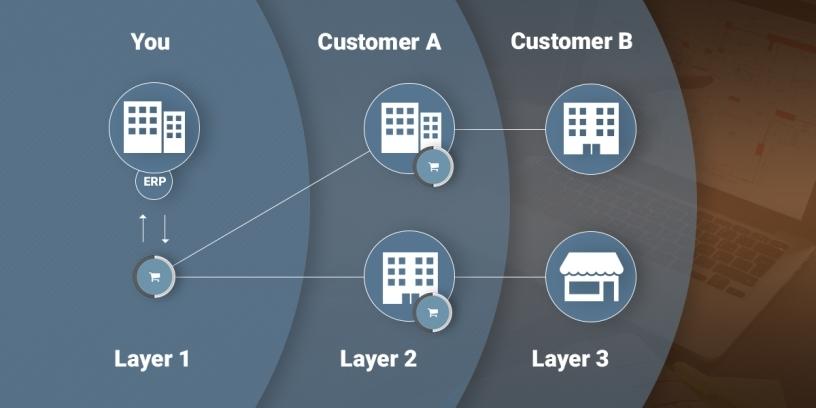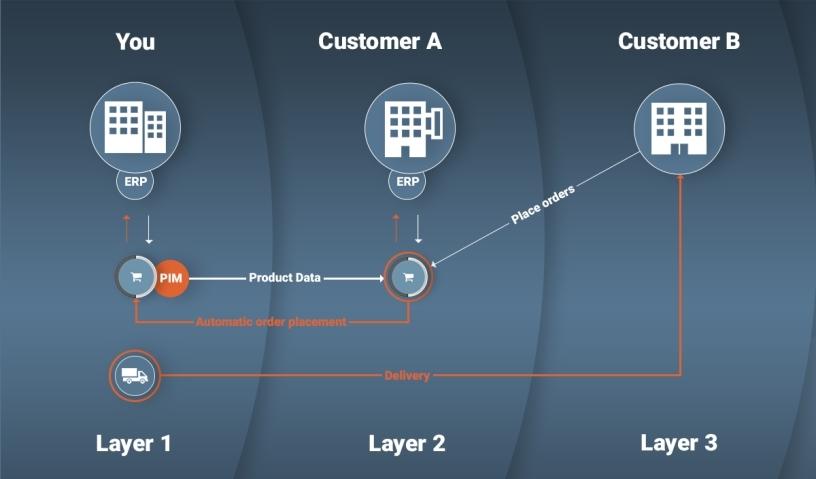
"One of the biggest challenges faced by B2B online businesses today is how to consistently grow their orders. Implementing this three-layer approach could increase your sales exponentially," says Jannie du Toit, CEO of Comalytics.
Are you tired of printing glossy catalogues that are only partly used and need ongoing price updates? Are your sales reps acting as order takers instead of strategic growth agents? Are you seeing your product information poorly managed by your customers' online systems? Do you sometimes want to reach further into your sales network than just your own customers, but don't know how to do this?
The Comalytics three-layered approach is a plug-and-play system that addresses these and other issues. It allows for many permutations, and is adaptable depending on your business needs. While implementing all the layers will give you a B2B drop-shipping model, it's your choice how much or how little of the three-layered solution you put into practice.
B2B layer one: Ordering made easy; one B2B online system for all your customers
The focus here is to implement B2B e-commerce within your own organisation. This eliminates the need for outdated, glossy catalogues or hunting for customer prices stored in different places. Instead, you automate sales by getting your own wholesale, distributor and retail customers to use your B2B e-commerce system.
Says Du Toit: "We have implemented Comalytics B2B e-commerce software for businesses with between 200 and 9 000+ wholesalers, distributors and/or retailers on their systems. Their Web sites display anything from 1 200 to 25 000 product items and we have witnessed sales growth in many, if not all, of them."
This happens for many reasons:
* With your non-EDI customers using your online system, orders from +/-80% of your customer base are now automated, and you are essentially offering 24/7 self-service.
* Those customers also have online access to their account details, specific prices and volume discounts. If your e-commerce store is integrated to your ERP system, they can see real-time stock levels too.
* Sales are broader and deeper per customer as they can see at a glance exactly what you sell, including items they didn't know you had.
* Keeping all your customer, product and sales information in one place, where everyone who needs to can access it, reduces admin, errors and duplication.
* Your sales team is freed up to be used more strategically, transforming them from finches into falcons.
All B2B e-commerce businesses start with this layer when they first go online, and very often remain there.
B2B layer two: Increase sales; implement identical product information throughout your customer network
It's an indisputable fact in the e-commerce industry that when your product data is accurate, complete and descriptive, and your images are attractive, you sell more.
If you have already taken the first, and most costly, step of transforming your print catalogues into electronic data, you can now use this data on your own systems for your own customers, but you still have two challenges:
a) Consolidating, managing and maintaining the quality of that data; and
b) Ensuring your entire network of customers and partners has access to the same data and uses it on their online systems to sell your products more effectively.
The solution is two-fold:
1) Invest in a product information manager (PIM)
A PIM application centralises all your product data, regardless of where it comes from. From this digital master location, you can:
* Edit and manage the data;
* Create individual buyer catalogues;
* Send product information to your sales network;
* Make marketing materials available to ensure brand consistency; and much more.
The PIM provides consistent and accurate product information at everyone's fingertips. Your entire team, partner structure and customer network can be confident that your product information is correct and always up to date.

2) Push better product data directly to your customers' online systems
In level one, you have invested in fantastic product information and you use it on your own B2B system for your own customers.
However, your customers (Customer A above) want to use your product information to sell to their customers (Customer B above). You can remain giving this data to your direct customers (Customer A) in the form of printed catalogues or send it to them electronically via spreadsheets. But, so much better, you can share product photos and descriptions, technical manuals, customer-specific prices and inventory levels directly with their online systems, so that their customers (Customer B) are better serviced.
There are many benefits to this, including:
* When your Customer A sets up their own Web site, they save time and money they would have spent on cleaning up and/or creating data.
* You have full control over the quality of the data being displayed down the line to your growing customer network.
* All customers can see your full range of products, and may well buy ones they haven't tried before.
This superior level of information increases sales both for you and for your direct customers.
B2B layer three: Take control; integrated ordering and fulfilment in one automated process
In this layer, you implement the following:

1) When Customer B places an order on the B2C or B2B site of Customer A, the order is automatically placed in your B2B e-commerce system. Customer A (your direct customer) no longer needs to manually consolidate and place orders, saving time and reducing errors and duplication.
2) The order automatically updates both your ERP system and Customer A's, keeping stock levels and other information up to date throughout the system.
3) In an optional additional step, this process can be extended to provide drop-shipping, where you deliver orders directly to Customer A's customer (Customer B). This is an extra income stream for you, and your direct customer no longer needs to hold stock or deal with fulfilment, but they still keep control of order processing and can track delivery.
Du Toit shares: "A manufacturer using our Comalytics B2B software approached several of their wholesale customers, and together we put in place integration across both systems. This integration streamlined the ordering and fulfilment processes while cutting costs for the wholesaler and growing the sales of both companies."
From the perspective of Customer A, there are many benefits to investing in this third-layer integration:
1) They automatically receive correct product information and inventory levels from you, their supplier. The integration updates this data as frequently as you decide.
2) With no need to hold slow-moving or very expensive stock in their own warehouse, they can sell a broad range of products with little investment.
3) They have no inventory or warehouse to maintain.
4) All packing and shipping is taken care of for them.
5) There are no minimum order requirements so they can order only what they need.
6) They can place orders 24/7.
7) They can track their orders online.
8) Their sales figures will be boosted, along with yours.
In summary
The three-layered approach gives you:
Layer 1: Automated own B2B sales
* What happens: A B2B e-commerce system is implemented and integrated with your own ERP system.
* Main benefit: Allows direct customers to order online 24/7. Customers can view account information, order history, invoices, prices, stock levels and more online.
Layer 2: Better efficiency and complete data quality control
* What happens:
- Implement a product information manager (PIM) for images, descriptions, codes, manuals, videos and more. Prices, stock levels and customer information remain in the ERP.
- PIM and B2B e-commerce systems integrate to direct customer's online systems, pushing product data, customer data and inventory levels to their ERP or directly to their B2B system.
* Main benefit: Your own product data is always up to date, housed in one secure digital place, making it easy to maintain. Full control of the quality of product data on your customer network. Automated distribution of selected product data to customers' systems.
Layer 3: Automated ordering process to third parties
* What happens: Ordering process is automated and integrated, B2B and ERP systems totally in sync with one another. Dropshipping model possible.
* Main benefit: You take control of customers' efficiency, provide secure and trusted data at all times, save time and money.
The Comalytics B2B e-commerce system can be customised to fit any business situation. So, whether you're a manufacturer or wholesaler who sells to other businesses, or you want to streamline online transactions with your own supplier base, there is a solution for you.
Share
